The Freedom to Walk
This year, I decided to hike Mt. Si to consider the meaning of Passover in a silent meditation up the mountain.
Every year, Jewish people gather with friends and family to tell the story of our enslavement in Egypt and escape to freedom. It’s a moment to savor our ability to gather and celebrate while acknowledging the injustice that surrounds us in an ever-broken world. Sharing the Seder with my kids fills me with joy, but it’s impossible to reflect on the meaning of Exodus when one of your kids is licking jelly off a knife and another one is belting out a song that only she knows.
This year, I decided to hike Mt. Si, just 30 miles east of Seattle and at the far western edge of the Cascade Mountains, to consider the meaning of the holiday in a silent meditation up the mountain the morning after our Seder. One of the most popular hikes near Seattle, it’s not technical, but has over 3,000 feet of elevation gain and culminates in a rock scramble. Even in April, there’s snow and ice on the upper portion of the trail.
I arrived early and started my hike in the predawn light. The air was crisp and cold, but the sky was clear, and it promised to be a bluebird day—perfect for a hike. Mt. Si. is just a few miles north of I-90, and your awareness of the interstate ebbs and flows with the contours of the trail. In the sections that run east-west, the traffic sounds ricochet off the face of the mountain and onto the trail, challenging my ability to hear anything else. When the trail shifts to a more north-south orientation, the din of traffic is replaced by the morning calls of robins; loud and lush, with more tone and texture than their cousins in the city. I understand these robins; like them, it’s easier for me to relax in the woods.
I turn around a bend in the trail and am greeted by the sharp drilling of a woodpecker. I can’t see it, but I hope that it’s a pileated woodpecker: crow-sized with black-and-white stripes and a vibrant red crest. The sound reminds me of a trip Allie and I took to Vermont 15 years ago, back when we still lived in Boston and were just beginning to bird. As we drove on a backroad, we saw our first pileated woodpecker fly across the road and land on a telephone pole. At that time, we didn’t know that these birds, while splendid, are rather common, and we stopped our car in the middle of the road to get out and gape. Thankfully, there aren’t that many cars on backroads in Vermont, and we were able to have a moment with our bird before he flew on, and we retrieved our car from the middle of the road and continued on our way.
I focused on my breath and tried to find a rhythm to my steps. When you get it just right, there’s something hypnotic about hiking at a standard clip, metronome-like. I find my gait, and start thinking about walking.
The same walk can be experienced very differently depending on your circumstances. When the Jews fled Egypt, they left on foot, leaving with such haste that they didn’t have time for their bread to rise. After the parting of the Red Sea, the Jews wandered in the desert for 40 years.
Walking is still how many people flee oppression and search for freedom. Every year, thousands walk through the jungles of the Darién Gap on a trip to the Southern Border of the United States. Some die en route, and those that make it await a fate that, though likely better than what they are fleeing, is increasingly ominous, with deportation to a modern day Gulag a very real possibility. And yet they continue to walk in search of freedom.
Those of us lucky enough to be born into freedom walk by choice, not necessity. Rick Ridgeway begins his great book on hiking from Mt. Kilimanjaro to the Indian Ocean with a paean to walking. He’s a mountaineer by trade, but would consider giving up the mountains for long walks. He’s not alone. Erling Kagge, the Norwegian explorer who was the first to reach the North Pole, South Pole, and summit of Mt. Everest on foot, revels in the transformative power of a long walk in his meditative Silence in the Age of Noise.
While long walks are the provenance of explorers and adventurers in our society, long walks were simply part of life throughout much of human history. In The Dawn of Everything, Graeber and Wengrow write about how, in pre-Columbian times in North America, people would think nothing of traveling hundreds or thousands of miles on foot, staying with members of associated clans as they traveled. On his travels through Kenya, Rick meets locals who would go for a walk around to wander for days on end with no clear destination or purpose other than the joy of walking.
We Americans still have this desire to travel, but our wandering happens in a vehicle hurling down the highway at 60 mph, missing damn near everything interesting as we listen to music or podcasts, crossing more miles in a day than Rick or Erling, traveling on foot, covered in a week. Our lives and experience are much poorer because of how we travel; a species apart, hurtling through our own artificial worlds.
I even see this detachment from the present on the trail. As I reach the first sign of snow, I see a hiker on her way down. She must have summited for the sunrise, something I’d like to do one day, and yet I can’t help but notice that she has AirPods in. I wonder if she took in the sunrise listening to a podcast, and if she she can reflect on what she saw with the disembodied voice(s) in her head.
I’m surrounded by Douglas firs now. Back in 1910, there was a massive fire on Mt. Si, and the burn marks from that fire can be seen on the base of the few older trees that were saved, for whatever reason, from the loggers. And yet if I didn’t know about the fire, I’d think that these woods were older, for the trees that surround me stretch well over one hundred feet into the sky. When combined with the placard about the fire, the lack of girth or grooved bark is why I think that these are relatively young woods. It seems to me that Douglas firs grow up, then out, and finally mature when their bark achieves its fireproofed and gnarled grooving with age.
I shed another layer. The sky is bright, though it’s still before 8am and there’s little sign of warmth coming from the sun. I look at the snow next to the trail and wonder if it fell when it rained in Seattle yesterday, or if it’s a remnant from earlier storms.
There’s a patch of ice near the top of the trail. I remembered my coffee, but forgot my poles and yaktrax in the early morning haze of leaving the house, and my knees scrape the ground as I lean forward and carefully make my way up the 100 feet of ice separating me from the summit. Never known for my balance, I proceed with caution, not wanting to ruin the moment.
I successfully navigate the ice and shoot out above the tree line. I scramble upwards until I find a rock where I can look out. To the south I see Mt. Rainier, to the East I see Seattle and Bellevue, small patches of humanity that seem insignificant in the face of the Olympic Mountains that form the skyline across the Puget Sound.
A Canadian Jay lands on the rock in front of me, barely an arm’s length away. Birds rarely get this close, but this one stays, looking at me. Another joins him. The wind puffs out their chest feathers and chills my fingers as I eat my Cheerios. I’d like to think that I’m having a moment with these birds because of my calm state of being, but I know that he’s hoping that I’ll leave some crumbs for him. I don’t, but the hundreds behind me on the trail likely will.
After taking in the view, I start the long descent, beginning with a successful, albeit slow, navigation down the ice patch.
It’s the same trail on the way down, but it feels different. The crowds change the trail; I can no longer ruminate on my thoughts, but rather turn my attention to greeting others, making way, and looking for sure places to place my feet. There is no silence to be had.
I finish the trail, head back to my house, and spend a day outside with my kids. Tired and sore, but happy and thankful for the time to myself that morning.
I think that to walk where you want, when you want—to stop and observe a stand of trees or listen to the water slicing down the mountain, just out of view but within earshot, removed from the sounds of modernity, and with no one around—is freedom.






great piece. i loved it.